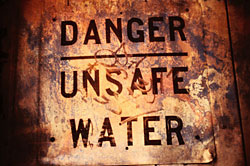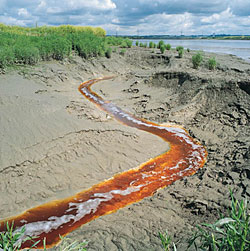  |
|
About Mission 2012:
Solving Complex Problems (12.000) is designed to provide students the opportunity
to work as part of a team to propose solutions to a complex problem that requires
an interdisciplinary approach. For the students of the class of 2012, 12.000
or Mission 2012, will revolve around the issues associated with the availability
of fresh clean water in western North America for the next century.
 Hundreds of millions of
people are being made ill every year or dying prematurely from water pollution.
Scientists estimate that more than a billion people lack access to clean drinking
water and that tens of thousands of people die each year from water-borne disease.
With the human population exceeding 6 billion and projections of 10 billion by
the end of the century the lack of fresh water will only become more severe. Hundreds of millions of
people are being made ill every year or dying prematurely from water pollution.
Scientists estimate that more than a billion people lack access to clean drinking
water and that tens of thousands of people die each year from water-borne disease.
With the human population exceeding 6 billion and projections of 10 billion by
the end of the century the lack of fresh water will only become more severe.Surface water and ground water reserves are being contaminated and over-utilized. International agreements concerning water use are often out-dated and based on inaccurate projections of populations and water use. For the students of the class of 2012, 12.000 or Mission 2012, will be tasked with solving the large and complex problems necessary to ensure the availability of clean, fresh water in the next century. When projections of global warming and climate change are considered, it is clear we are in severe crisis. Climate models predict that major shifts in rainfall and climate will occur over the next century that will impact water agreements between countries with the potential of triggering major international disputes, if not war. Solving this problem is essential for global political and economic stability and social justice of all people. Mission 2012 will focus on the complex issues associated with future water use and planning for western North America along the western corridor from Canada to Mexico, including the southwestern United States. The problem you, as a Mission student, must solve is how to ensure a continuing supply of clean water in the face of a rapidly growing population, increasing dependence on food grown on irrigated land, degradation of water quality, popular pressure to return rivers to their wild state, water use and contamination in production of fossil fuels, and the legal requirements to deliver a supply of fresh clean water to Mexico while maintaining the health of the Gulf of California. Your solution must consider international treaties between Canada, Mexico, and the United States, how we value water and the economics of natural resources, and how to develop a comprehensive plan for sustainable development for the 21st century and beyond. Ideally your plan will serve as a template for other regions of the planet that face similar issues. r other regions of the planet that face similar issues. Mission 2012 is also part of the Terrascope program and the issues associated with water use in the western US and Mexico will be a year long theme of Terrascope. By enrolling in 12.000 you become part of the Terrascope program and community, even if you do not continue in the Spring. Spring Field Trip: During spring break in March of 2009 we will take a field trip to the boundary regions of both the United States and Mexico to explore the history of water use and exploitation, treaties between Mexico and the United States, political and social issues, and the future of agriculture.  About 12.000: About 12.000:"Solving Complex Problems" (12.000) is a nine-unit, Fall-semester subject designed to provide freshmen with the opportunity to work as part of an "imagineering" team to design a viable solution to a complex problem that requires an interdisciplinary approach. It is also known as Mission 2012 -The Future of Fresh Water. Each year's class explores a different problem in detail through the study of complimentary case histories and the development of creative solution strategies. It includes training in web site development, effective written and oral communication, and team building. Initially developed with major financial support from the Alex and Britt d'Arbeloff Fund for Excellence in MIT Education, 12.000 is designed to enhance the freshman experience by helping students develop contexts for other subjects in the sciences and humanities, and by helping them to establish learning communities that include upperclassmen, faculty, MIT alumni, and professionals in science and engineering fields. Why Mission? The Mission class offer freshman a completely different way to learn. In contrast to the core classes that rely on lectures and problem sets, Mission attempts to teach students how to think about solving complex problems. Students in Mission are independent, largely self-directed, and interactive. They learn how to build teams and develop solutions that require teamwork between scientists and engineers. Mission students will learn that many problems are just too big and complex to be solved by any one person or discipline and must involve integration. At the end of the class the students of Mission will have developed new and innovative solutions to an "unsolvable" problem and been exposed to a variety of different disciplines.  History of the Class History of the ClassProfessor Kip Hodges, now at Arizona State University, conceived of the course and supervised it for the first six years. It was offered first in Fall 2000, when the assignment (Mission 2004) was to develop a viable mission plan for the exploration of Mars with the aim of finding evidence for the present or past existence of life. The assignment for Fall 2001 (Mission 2005) was to design undersea research stations for both coral reef and abyssal environments. Fall of 2002 (Mission 2006) charged students with developing a strategy for monitoring and preserving the Amazon Rainforest. As in previous years, the students in Mission 2006 described their final design in a content-rich web site and an oral presentation in front of a panel of international experts. Mission 2007 was focused on Arctic National Wildlife Refuge (ANWR), Mission 2008 on a sustainable future for the Galapagos, and Mission 2009 on developing a global plan to deal with Tsunamis. In 2006 Sam Bowring took over 12.000 from Hodges and started with Mission 2010 - Saving N'awlinz, followed by Mission 2011 - Saving our oceans. |
 |
  |